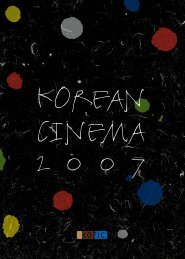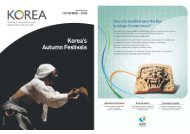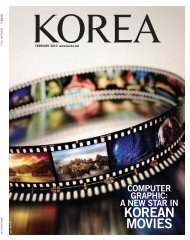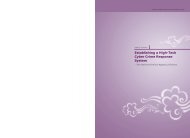HELLO from KOREA
Hello-Eng(3.3) - Korea.net
Hello-Eng(3.3) - Korea.net
- No tags were found...
You also want an ePaper? Increase the reach of your titles
YUMPU automatically turns print PDFs into web optimized ePapers that Google loves.
Sculpture<br />
Unlike paintings on paper or silk,<br />
stone or metal sculptures <strong>from</strong> early<br />
Korean history were sturdy enough to<br />
leave behind ample testimony to the<br />
importance of Buddhism in Korea's<br />
history and culture. Historically, most<br />
and the best Korean sculpture is<br />
Buddhist, or rather, is Buddha.<br />
The first Korean Buddhas,<br />
of gilt-bronze and clay, date<br />
back to the sixth century and<br />
were found in Goguryeo. The<br />
Baekje and Silla kingdoms<br />
began to make Buddhas in their<br />
own styles shortly after. Buddhas<br />
<strong>from</strong> Goguryeo had rigid bodies,<br />
big hands, big usnisas (round<br />
bumps on top of the head<br />
that symbolize Buddha's<br />
supreme wisdom), and barely<br />
a smile on their long, thin faces.<br />
Buddhas <strong>from</strong> Baekje, on the<br />
other hand, are famous for their<br />
benevolent, definitely smiling<br />
faces and are warmer, more<br />
subtle than the Goguryeo's. The<br />
Silla Buddhas had round faces with<br />
geometric, stylized features with<br />
smiles more subtle than Baekje's and<br />
realistically sculpted bodies. The<br />
most magnificent Buddha in<br />
Korea is in the Seokguram<br />
Gilt-bronze Maitreya<br />
(early 7th century)<br />
49 _ Culture
















